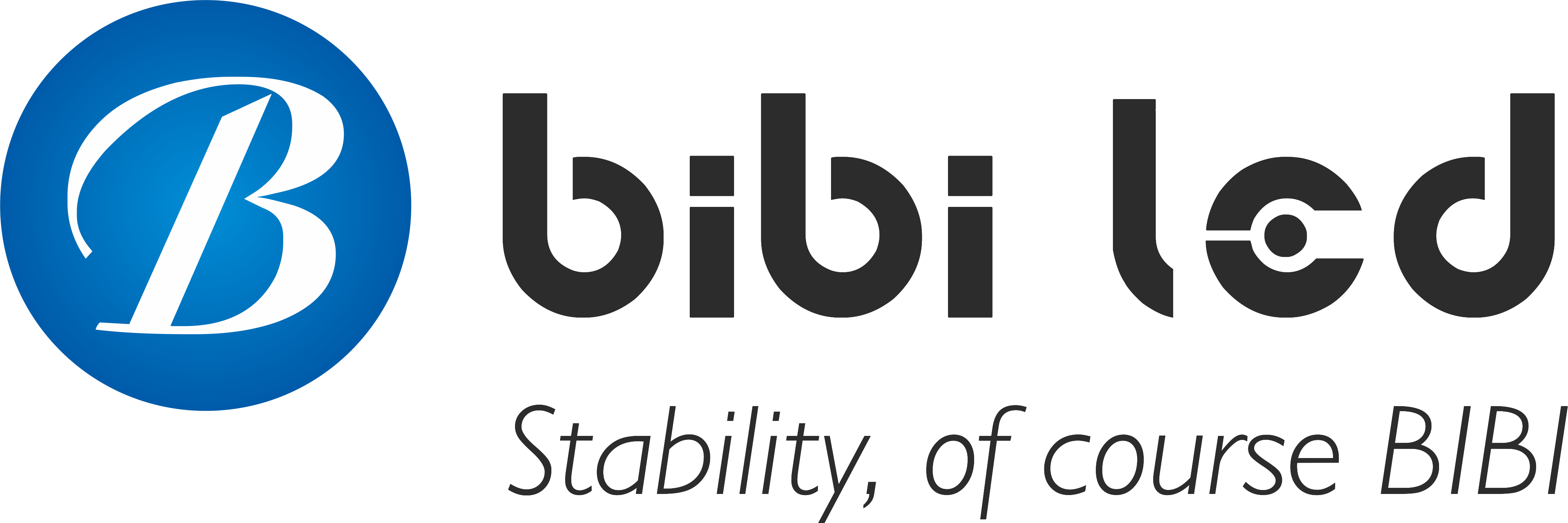Introduction
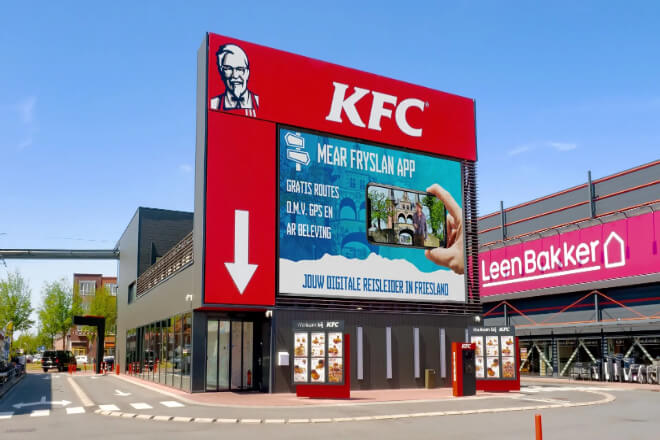
In windy cities, how can Écrans d'affichage LED be safe, stable and durable? Is it enough to just rely on a strong bracket?
This article will reveal the key steps of wind-resistant reinforcement of LED screens, from site selection, bracket design, to intelligent monitoring and emergency plans.
And comprehensively analyse how to make LED screens as stable as a rock in strong wind environments.
Table des matières
Step 1: Choose a suitable installation location
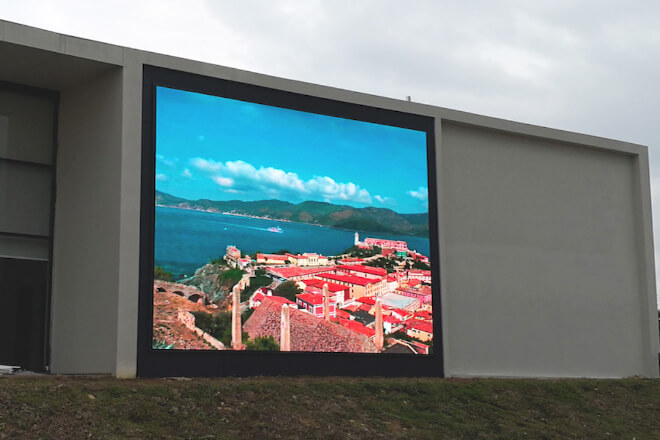
In cities with strong winds, choosing a location is the most critical step when installing LED screens.
Don’t just think about how strong the steel frame is; where it is installed actually determines whether the screen can safely withstand strong winds.
1). Avoid obvious wind outlets
There are many places in the city where the wind is particularly strong, such as the gaps between high-rise buildings, subway entrances and exits, and open areas by the river or river.
The wind ducts formed in these places allow the wind speed to be concentrated and amplified.
If the LED screen is installed in these locations, the screen will be subjected to very uneven forces, resulting in structural fatigue and shortened life.
In this case, try to install it away from the wind outlet to keep the screen away from the “wind knife”.
2). The higher the height, the greater the wind pressure, so you need to pay special attention to it.
Many customers like to install the screen higher so that the display range is wider. But the increase in wind pressure caused by the height cannot be ignored.
Generally speaking, the wind speed increases with the increase in height, and the wind pressure above 20 meters may be twice or even more than that on the ground.
If the design is only calculated according to the ground wind speed, it is easy to cause safety hazards in actual use.
When installing at high altitudes, structural reinforcement must be strengthened, and the selection of materials and connectors must be stricter.
3). Remember to comply with local laws, regulations and construction specifications
Not only a technical issue, but the location selection must also comply with the city’s construction and advertising management regulations.
Some places have specific requirements for the installation height, wind resistance level, and connection method of LED display screens with buildings.
Understand the local approval process and specifications in advance to avoid forced demolition or rectification due to non-compliance after installation.
Doing a good job of compliance is not only a safety guarantee, but also the key to the smooth progress of the project.
In general, reasonable site selection is more important than simple reinforcement. If the location is right, the subsequent reinforcement work will be more effective, and the LED screen can stand in the wind more safely.
Step 2: Design and material selection of reinforcement bracket
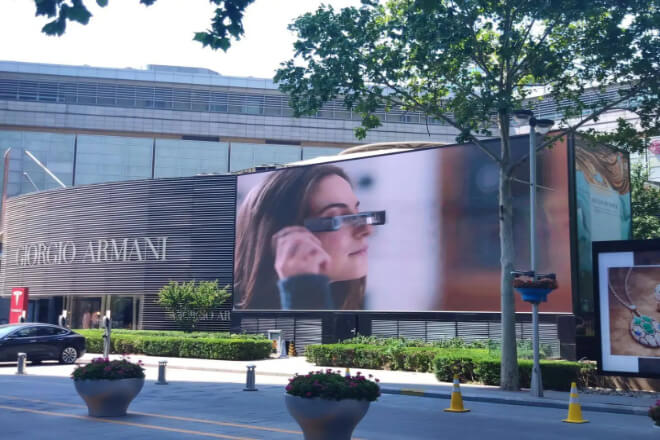
After selecting the installation location, the next most important thing is to build a “skeleton” for the LED screen – the design and material selection of the bracket.
Whether this step is done well or not directly determines whether the screen can withstand the test of wind.
1). The bracket design should be strong, and the material should be wind-resistant
Steel structure is the most reliable material for wind resistance. It has high strength and good toughness and can effectively withstand the impact of wind.
Compared with aluminium alloy or other lightweight materials, steel structure is more durable and easier to reinforce.
When designing, the bracket should be an integral frame, and the force should be evenly distributed to avoid wind pressure being concentrated on a certain pillar.
This can prevent the structure from being overstressed locally, causing deformation or damage.
2). Anchoring technology should not be ignored
If a strong bracket is not fixed firmly, it will still be unstable when the wind blows. The anchor point must be buried deep in the foundation or close to the building structure.
And use expansion bolts, steel sleeves and other fasteners to ensure that the bracket will not be blown or even shaken by the wind.
Some high wind speed areas will design brackets with ventilation holes or breathable structures, so that wind can pass through, reduce the windward area, and effectively reduce pressure.
3). Choose the right bracket type to ensure wind resistance
Single-column brackets are suitable for small screens or areas with low wind speed. They are easy to install but have limited wind resistance.
Double-column structures are stronger and can disperse wind pressure, making them suitable for medium and large screens.
Frame brackets are the strongest type, especially suitable for large screens and strong wind environments, but they are also the most expensive and difficult to construct.
Which one to choose should be considered in combination with the screen size, installation height and local wind conditions.
In short, if you want the LED screen to withstand the wind steadily, the bracket design and material selection must not be casual.
Only if the frame is hard enough can the screen run safely and reduce maintenance troubles.
Step 3: Wind speed sensing system and intelligent adjustment
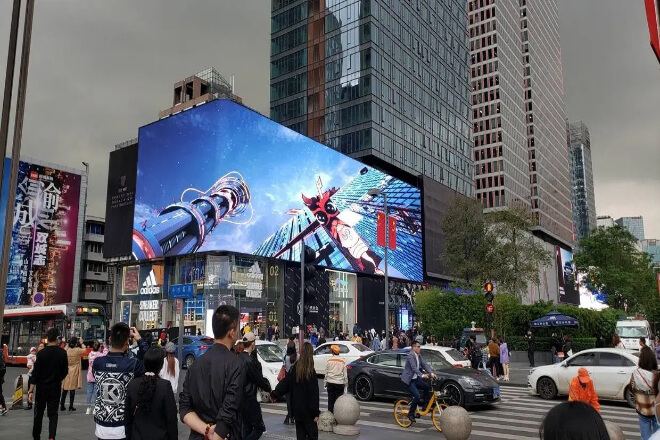
In places with strong winds, it is not enough to rely on a strong bracket alone. It is more reassuring to install a “wind speed sensor” on the LED screen.
It is like a “radar” for the screen, monitoring the wind at any time, so that you can know whether the screen is in danger at the first time.
1). Monitor wind speed in real time, don’t wait until the wind blows to panic
The wind speed changes every day, especially in windy cities, where the wind speed varies greatly from morning to evening.
Installing a wind speed sensor can transmit the on-site wind speed data to the screen control system in real time, ensuring that the wind speed changes are clear at a glance.
The sensor is generally installed near the LED screen, and some even install multiple sensors to ensure accurate and reliable data.
In this way, the system can adjust the screen status according to the real-time wind speed and take precautions in advance, rather than waiting for the wind to blow strong before discovering.
2). When the wind speed is high, the screen automatically “transforms”
The system sets different wind speed thresholds. Once the wind speed reaches the warning level, the screen will automatically reduce the brightness.
Reduce consommation d'énergie and equipment heating, and protect the internal components from being overloaded.
If the wind is stronger, such as approaching strong wind or storm levels, the system can also automatically turn off the display screen to prevent the screen from shaking too much, causing structural damage or electronic component failure.
When the wind is small, the screen will automatically resume normal operation without manual intervention, saving a lot of maintenance costs.
3). Reasonably set the wind speed threshold to avoid misoperation
The threshold setting should be scientific and not too sensitive, otherwise it will be adjusted frequently when the wind blows, affecting the display effect; it should not be too slow, and the protection will not be in place.
Generally, it will respond on multiple levels according to the local maximum wind speed data and the wind resistance level of the screen design.
For example, the brightness will be automatically reduced when the wind speed reaches level 5, and it will be automatically turned off when it is above level 8, and it will automatically start again when the wind is small.
Such grading measures not only ensure safety, but also take into account the daily use experience.
4). Remote monitoring makes management more worry-free
Most modern wind speed sensing systems are equipped with remote monitoring platforms.
And operation and maintenance personnel can check the wind speed and screen status online at any time, and warn and deal with potential problems in advance.
The accumulated wind speed data can also help optimise wind protection plans and maintenance plans, and improve the overall life of the equipment.
Remote management greatly reduces the pressure on on-site personnel and improves operation and maintenance efficiency.
Step 4: Regular inspection and maintenance
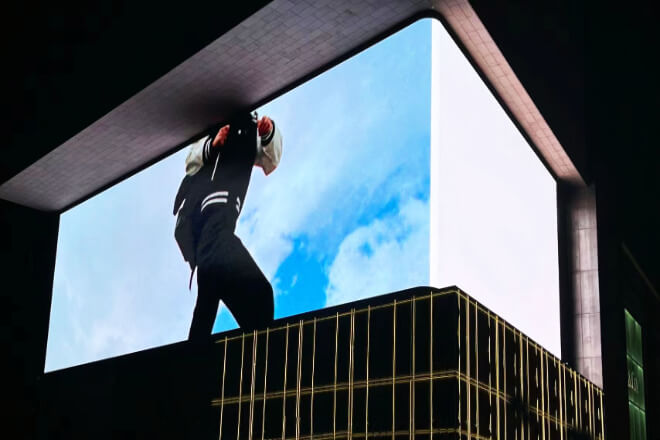
No matter how strong the bracket is and how intelligent the system is, there will always be wear and ageing over time.
For LED screens in windy cities, regular inspection and maintenance are the last line of defence to ensure safety and stability, and must not be ignored.
1). Brackets and connectors should be “checked” frequently
Brackets and various connectors are the “bones” and “joints” of LED screens. They are exposed to wind and rain, and bolts may loosen, weld fatigue may occur, and steel corrosion may occur.
Regular inspections of these parts to confirm that there is no looseness, rust, or cracks are the key to preventing accidents.
Especially after strong winds, inspections should be strengthened to promptly discover and tighten or replace problematic parts to prevent small problems from turning into major hidden dangers.
2). Maintain wind speed sensors and electrical systems
Wind speed sensors, controllers, and power supply systems, which are “nerves” and “blood vessels”, also need regular maintenance.
If the surface of the sensor is dusty or damaged, the monitoring data will be inaccurate. Ageing or poor contact of electrical equipment will affect the normal operation of the intelligent adjustment.
Clean sensors regularly, replace old lines, check power supply voltage regulators and protection devices, ensure that the entire system is sensitive and stable, and avoid monitoring failure.
3). Timely replacement of aging or damaged components
After a long period of use, any component will inevitably age. Don’t delay replacement with the mentality of “it can still be used”, as this will increase the risk.
It is recommended to formulate an equipment life management plan and replace key components in time according to the service life.
Such as high-strength bolts, electrical accessories, wind speed sensors, etc., in steel structures, to ensure that the equipment is in good condition for a long time.
4). Establish a complete inspection and maintenance file
Keep a record of the content, problems found and handling of each inspection and maintenance, so as to facilitate future tracking and analysis.
This will not only make it more scientific to arrange subsequent maintenance, but also provide a clear basis for safety responsibilities.
Step 5: Wind disaster prevention measures and emergency plans
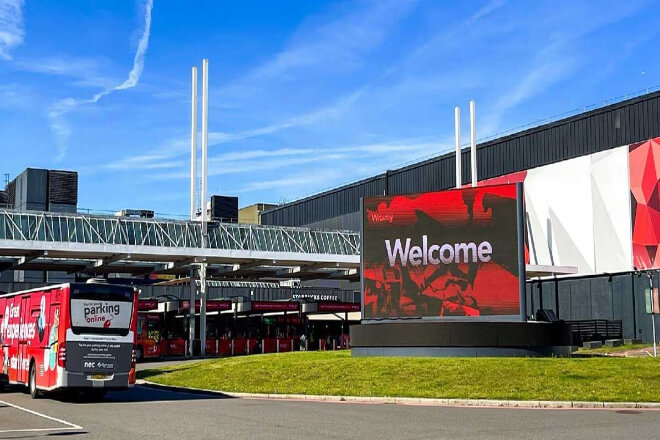
In the face of wind disasters, making preventive and emergency preparations in advance can minimise losses and ensure the safety of LED displays and personnel.
1). Rapid emergency response when disaster strikes
Once a strong wind or typhoon warning is received, the operation and maintenance personnel must immediately activate the emergency plan.
Although the system is intelligent, manual intervention is important at critical moments.
The LED display can be manually turned off to avoid long-term operation and increase the burden on the equipment.
You can also adjust the display content to avoid playing dynamic or high-brightness images, reduce power and heat, and reduce the risk of failure.
Quick response is the first line of defence to protect the screen.
2). Shutdown strategy in extreme weather
For extreme weather, especially when the wind speed reaches the design limit, it is recommended to shut down the display screen in advance to avoid structural damage to the equipment due to excessive wind.
Shutting down in advance can also prevent the display screen from being distorted and electronic components from being damaged due to wind shaking.
Before shutting down, make sure that the shutdown operation is correct to avoid secondary damage to the equipment caused by a sudden power outage.
3). Inspection and recovery after the wind disaster
After the wind disaster, it is very important to conduct a comprehensive inspection as soon as possible.
Check whether the brackets and connectors are loose or deformed, whether the wind speed sensor and electrical system are working properly, and whether the surface of the screen is damaged.
According to the inspection results, repair or replace the damaged parts in time to ensure that the screen resumes safe and stable operation.
At the same time, keep a record of the wind disaster, summarise the experience, and improve the emergency plan.
6. Conclusion
Strong winds are not terrible; the key is whether you are fully prepared. Has your LED display screen been reinforced to resist wind?
You may wish to refer to the strategies in this article, plan ahead, and take scientific precautions to make the screen fearless of wind and rain and safely and steadily convey brand value.
Enfin, si vous souhaitez en savoir plus sur les écrans LED, merci de nous contacter.
